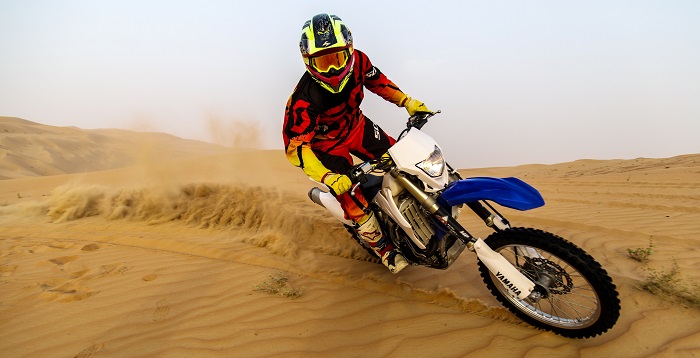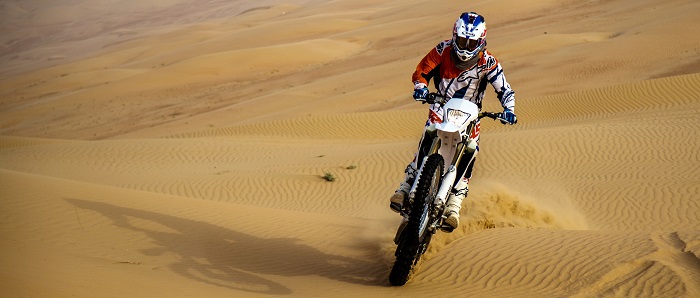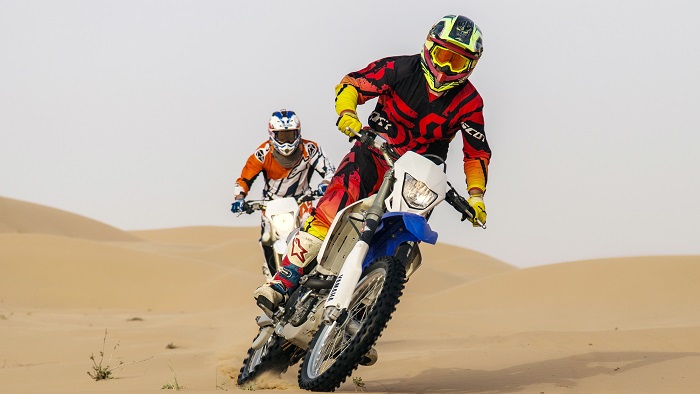I’m writing this fourth installment in my Abu Dhabi Desert Challenge story in a good place, but with some frustrations. There is just over a month to go before the rally starts and I can feel it looming.
So let’s look at the frustrations first and get them out of the way. There are two major problems. First off is my rally bike is not yet built. If you’ve been following these articles you may recall that around Christmas the Gas Gas project came to an end and the Yamaha WR450 Rebel X project took its place. The WR450 base bike is here and I’ve been racking up the hours getting used to its different feel but the rally kit (navigation tower and instrumentation, extended range tanks and bash plate with water and tool storage) is trapped in Dubai customs/DHL somewhere. I’m really keen to get on it and become completely at home riding it.
Frustration number two is a day’s riding I had a couple days ago. I’ve just spent the past week down in the Liwa Crescent on a training camp with James West (Crazy Camel Racing) and some fellow ADDC competitors. For some reason on the fourth day I lost my riding mojo. A couple of minor falls and struggling on some complex slip faces going against the grain led to more falls and more struggling. With each problem my riding became worse and worse.

The route we were riding for the day was combination of previous year’s rally routes but in reverse. This meant we were going ‘against the grain’. Those who have driven or ridden in the dunes will know they have a natural grain like wood or waves in the sea. This is caused by the prevailing wind. On the side the wind mainly comes from the dunes are less steep and the sand more compact. The slip faces form on the other side, the lee, out of the wind. The sand here is soft and at its steepest. Against the grain means you are tackling this steep, soft stuff.
It’s not all one big slip face though, there are weaknesses, joining the dots between these creates lines to ride. But they are tough lines requiring both momentum and traction. Because the sand is at its softest carrying speed keeps the bikes wheels from digging in. But of course you can’t just go flat out like its flat. Concave depressions cause compressions and G’s that can be impossible to hold. Convex ‘bumps’, even when soft sand, can launch you into the air. This is not so much a problem, it’s the landing that’s the problem. Soft sand is also difficult to turn on feeling vague and robbing valuable momentum.
Then there is traction needed to keep your optimal speed going as you fight the gravity and drag of the sand while climbing up the dunes. The aim is to have just enough power to the back wheel, not enough and you lose that precious momentum, too much and either you will be too fast with its associated problems or the rear wheel will spin too much and dig right in losing drive and speed again.
If it all sounds difficult it’s because it is a bit!
There is one more problem too. At the top of every dune there is exactly that, a top and end. The steeper the dune the more sharply it finishes. It’s very important to judge your speed correctly at this transition, too fast and you get launched into orbit, too slow and you won’t make the top.

When it’s all going well all is good, you can see the lines, hold the transition at the bottom, keep your momentum, judge your speed correctly at the crest and flow through dune after dune. It’s tiring but feels great. Make a mistake though and suddenly you are picking a bike up in the middle of a soft slip face and that’s very tiring making the next mistake more likely and this is how it can snowball. This is what happened to me. It was horrible. I was making all the mistakes resulting in a loss of confidence which directly leads to a loss of flow and momentum, more fighting picking up the bike, more energy burned quickly all resulting in more confidence-robbing mistakes.
I felt like an accident waiting to happen plus it’s no fun being constantly being off the back of the group, getting dropped and feeling like you are holding everyone else up unacceptably. I didn’t seem to be able to shake it so at the refuel stop I decided to quit while I was ahead and leave the other guys to crack on without me. Better to walk away and be ready to play another day?
Day 5, I was back on the bike, the weather was poor (start of the sandstorm) and the pace down as a result. I didn’t have any offs but felt stiff and lacking flow on the bike.
I’m confident these two frustrations should solve themselves with a combination of bike time and patience. The Rebel X Rally Kit is here somewhere and there are more on the way (we will be a team of six riders for the event). My missing mojo will come back with time on the bike and I’m planning on heading to some big dunes to work on the weaknesses I found in my riding.
Now what’s going well? Firstly the ankle I broke back in October is healing well and feeling stronger and stronger each time on the bike. It’s now not restricting my riding at all, just feels a bit sore and stiff in the mornings or at the end of a long day.
Next is my riding has been feeling good and I’ve been finding lots of flow over recent weekends. In the three days prior to losing my mojo down in Liwa, I felt I was riding well and felt comfortable on the bike in the terrain. I’m comfortable in the environment, I know how the dunes feel down there and know the topography reasonably well now. I’m happy with the kit I wear and that I can stay fed, hydrated and comfortable for full rally days in the expected temperatures and sun. Doing five consecutive days of more or less rally distances has allowed all those first timer concerns to melt away.
I’m really happy and confident with the rally bike plan. WR450s are well proven to be reliable in our prevailing conditions, even through the summer, so are an excellent base bike. The Rebel X kit brings together components proven for functionality and reliability over many of the world’s toughest races.

Most importantly, I’m most happy with the group of people I have around me supporting me in this endeavour. James West and his crew with their race experience and riding ability are huge assets to have in my camp. They tolerate my ‘noob’ inexperience, stupid questions and by riding with them, give my riding a head start by ensuring I’m learning from their experience and the best lines. During the rally their team, Crazy Camel Racing, will be providing their race proven support, bike servicing and logistics.
I’m also lucky enough to have Malcolm from Dune Raider Desert Racing Team as a mentor. With several successful DCs in the bag his patient experience has been invaluable when evaluating where I’m at, bouncing thoughts around and planning the path forwards.
Lastly over the past few months I’ve met a lot of fellow competitors and teams. I’m looking forward to the comradery of the bivouac and being part of a world championship event. My understanding is that because it’s the first round of the FIM World Raid Rally Championship a successful finish will actually give me a world ranking. That’s kind of cool.
As this will be the last article issue that goes to print before the event start on the 27th March 2015 I’d like to take the opportunity to wish everyone involved the best of luck and a safe rally. That includes not just the competitors but also the huge team of people supporting the event to make it happen, the mechanics, marshals, cooks, medical team, helicopter pilots, sweep team, photographers and journalists. The list is long but everyone is appreciated by this newbie competitor.
For more information on the event go to www.abudhabidesertchallenge.com.

